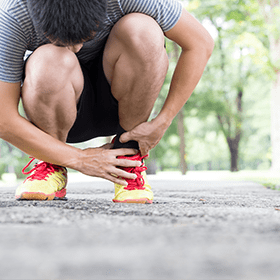By Ben Fletcher
5 Exercises for Lower Back Pain
Back pain is very common and has been reported to account for around 7% of GP consultations.
AM Elliott et al. (1999) found that one in six people aged 25 and above had reported back pain which had lasted more than three months. This is even before we consider those who are obese, physically inactive or who have suffered from injury, all of whom are at higher risk of back pain. In addition, mental health conditions have been reported to increase the likelihood of developing some musculoskeletal disorders. For example, in a 2005 study by Manek and MacGregor, people suffering with depression were found to be at a greater risk of developing back pain.
More often than not, lower back pain isn't serious, improving within weeks or months. Occasionally, lower back pain can be more serious, resulting from disease or damage to the tissues of the back. Therefore, it is important that you seek professional advice if any of the following apply to you:
- Your back pain occurs after a traumatic event such as a car accident
- Your back pain doesn't improve when resting, or wakes you during the night
- You experience high temperatures, chest pain, or unexplained weight loss
- Your back pain is accompanied by numbness or a tingling sensation experienced in you bottom, legs or feet
- Your back pain is accompanied by changes to your bowel or bladder control
- You have swelling in your back
Managing lower back pain
If it is likely that if you simply have lower back pain without any additional issues then the problem should resolve itself. There are a number of ways in which you can help speed up your recovery, however. The most beneficial method is to stay as physically active as possible, which has been found to be a great way to help manage lower back pain. When you are experiencing discomfort in your lower back, one of the worst things you can do is rest lying in bed, sitting on the sofa and curtailing physical activity altogether. All you need to do is swap high intensity workouts for something lighter, such as cycling. Other than that you should try to maintain as normal a lifestyle in terms of exercise as possible.
In addition, you should try not to worry about your back pain. Thinking the worst has been found to increase the pain, and over time, the worry can become a bigger problem than the pain itself.
How should you stay active?
Exercise is a great remedy for lower back pain. There isn't any particular type of exercise that is best, staying as active as you can is the best recommendation. Avoid activity and movements that aggravate the pain, however.
Staying active means different things to different people, so you need to think about what it means for you and the different types of exercise you enjoy. For example, some people will enjoy gardening to stay active, which is fine, as long as heavier work is avoided. If long distance running is your preferred way of staying active, then continue training all you need to do is reduce the volume and intensity of your training while back pain is still present.
If you are not already exercising regularly, the onset of lower back pain may be your signal to start. Walking, swimming and cycling are all activities that will help you become active and stay active. Yoga and pilates are also popular forms of activity for individuals with lower back pain.
It is important to note that being physically active keeps you happy and focused on the important things in life. Therefore, in addition to relieving your lower back pain, staying active will help to ensure that other aspects of your health do not decline too.
Here are some exercises you can perform to get you started:
Knee Roll
Place your knees and feet together. Roll your knees from side to side. Push your shoulders into the floor to ensure they stay in contact with the ground.
Knee to Heel
Place your feet slightly wider than hip width apart. Alternatively take the inside of your knee towards the opposite heel in a controlled movement. Push your shoulders into the floor to ensure they stay in contact with the ground.
Pelvic Tilt
Lie on your back with your knees bent. Flatten your back against the floor by engaging your abdominal muscles - notice your ribs lowering and your pelvis tucking.
Notice that when you relax, your ribs flare and your back arches off the floor. You should practice engaging and relaxing your core to flatten your back as well as holding the position.
Deadbug Isometric Hold
Following on from the previous exercise (pelvic tilt), begin with flattening your back on the floor before alternatively bringing your legs up to the 90-90 position. Hold this position whilst keeping your core engaged - it's really important that your back stays flat on the floor and it doesn't arch up.
Hamstring 90-90
Raise one leg so your hip and knee are both at 90 degrees. Support your raised leg with your hands. In a controlled movement, straighten and bend your leg.
As you start to recover
When your back pain was at its worst, if you followed the above, you were staying active to help reduce the symptoms and stop yourself from getting worse. As your symptoms of lower back pain start to improve, you will want to keep moving in this direction, and there is moderate evidence to suggest that performing exercise post back pain can help to prevent another episode of lower back pain. There are a number of ways in which you can reduce the risk of another episode of lower back pain.
Progressive training: To keep improving physically, your exercise programme must become gradually become more difficult. For example, if you were walking to stay active, to progress your training, you should walk further, faster or take a hillier route.
Increase your range of motion: As your lower back pain starts to reduce, it is a good idea to introduce some stretching exercises targeting the spine and the muscles surrounding your hips. This would be a good time to begin some yoga or pilates if you haven't already started.
Strengthening: As lower back pain eases, muscle strength, in particular the small muscles that stabilise the lower back, does not return automatically so you should consider doing some specific strengthening exercises, again with progressive difficulty to ensure strength is increasing. You should also perform other muscle strengthening activities which target the major joints and muscle groups in the upper or lower body.

